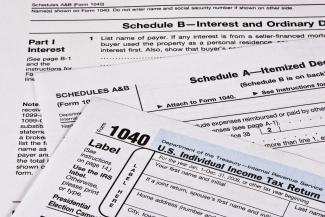
Optimizing Itemized Deductions
Background
The Tax Cuts and Jobs Act (TCJA) of 2017 nearly doubled the U.S. Federal Income Tax Standard Deduction and eliminated or restricted many itemized deduction options for tax years 2018 through 2025. The intent was to simplify the preparation of tax returns by allowing more taxpayers to take the standard deduction instead of itemizing real estate taxes, medical expenses, charitable contributions and other deductible expenses each year. As a result, the TCJA significantly decreased the number of taxpayers claiming itemized deductions.
Many taxpayers can still leverage Itemized Deductions to get a larger tax reduction than the Standard Deduction offers. This article is intended to help people optimize the tax reduction impact of expenses that can be itemized on Schedule A of the U.S. Federal Income Tax return by using a technique called “Bunching Expenses”.
Topics Covered in This Article
- Definitions
- Expense types that are easiest to “Bunch”.
- An Example of “Bunching” itemized deductions
- Other considerations
Definitions
- Standard Deduction: a fixed deduction amount based on the taxpayer’s filing status and conditions related to age and disabilities. The IRS adjusts the standard deduction annually for inflation.
- Itemized Deduction: costs paid by the taxpayer for qualified categories including medical and dental expenses, state and local income taxes, real estate and property taxes, sales taxes, mortgage interest, gifts to charity, certain casualty losses and other miscellaneous items.
Either the Standard Deduction or the Itemized Deduction is subtracted from the taxpayer's Adjusted Gross Income to establish the taxpayer's Taxable Income. Thus, the larger the Deduction, the less tax paid by the taxpayer.
- Schedule A: a form included with a taxpayer’s Federal income tax return which is required for any year they choose to itemize deductions. Schedule A has seven categories of expenses: medical and dental expenses, taxes, interest, gifts to charity, casualty and theft losses, job expenses and certain miscellaneous expenses.
- Bunching: a tax strategy in which the taxpayer alternates the use of the Standard Deduction and Itemized Deduction in consecutive years to reduce the overall tax paid over the multi-year period. This technique is accomplished by timing the payment of certain deductible expenses to maximize the amount of Itemized Deductions taken in certain years.
Expenses that are Easiest to Bunch
Bunching can work with any expense that can be itemized and which the taxpayer can control when the expense is incurred. This typically leads taxpayers to bunch expenses in three key areas:
- Property taxes. If allowed without imposing late fees or interest, wait until early January to pay the previous year’s property tax bill. Then, pay the current year’s property tax bill in December of that same year. Since two property tax bills were paid in a single year, the amount that can be itemized has been doubled for that tax year.
Note that the amount of property tax that can be deducted is capped at $10,000.
- Health expenses. It is important to note that unreimbursed medical and dental related expenses must be above 7.5% of the taxpayer’s adjusted gross income before they contribute to the Itemized Deduction total. For taxpayer’s who have a high-deductible insurance plan, pay significant out-of-pocket qualified health-related expenses, or can predict an upcoming large health care expense such as elective surgery, birth of a child, or assisted living facility initiation fee, they can try to coordinate these expenses with other bunched itemized deductions.
- Charitable contributions. Charitable contributions are a common expense that people have itemized. The timing of a charitable contribution will typically be at the discretion of the donor (taxpayer), so these are the easiest to manage when bunching deductible expenses. There are two common techniques for bunching charitable contributions:
- Double the amount that is given to charity in the “bunching” year and skip charitable donations the previous or following year. A common timing sequence for this option is to donate in January and December of the year in which bunching is leveraged. This allows the donations to be made on an approximately-annual basis for the sake of the charity’s income management, while doubling the contribution amount for the taxpayer in the bunching year.
- Establish a donor-advised fund (DAF). A DAF lets you make a large charitable donation in a particular tax year and take the itemized deduction in that year. The assets within the DAF are invested and eventually paid to eligible institutions based on the discretion of the Fund manager. A DAF is attractive when a taxpayer wants to make several years’ worth of contributions in a single tax year. The IRS imposes caps on the amount of charitable contributions allowed in a single tax year based on the taxpayer’s AGI, and some DAF investment managers specify minimum DAF contribution limits.
An Example of “Bunching” expenses
Charles and Diana are a married couple living in Wake County, NC who file jointly with no children. Annually, they have $23,000 of itemized deductions, including $10,000 in charitable donations and $4,000 in property taxes on their home. Let us look at two options for 2023 and 2024, when the standard deduction for a married couple will be $27,700 and $29,200, respectively.
Option 1: continue making their deductions as noted above, which yield an itemized total below the Standard Deductions. Thus, they will have a total Standard Deduction of $56,900 over the two years.
Option 2: bunch their property tax payments and charitable contributions into 2023, yielding a 2023 Itemized Deduction of $37,000. Wake County allows payments of their property tax for a given year to be made as late as January 5th of the following year without incurring interest or penalty.
|
|
Option 1 |
Option 2 |
||
|
Tax Year |
2023 |
2024 |
2023 |
2024 |
|
Charitable deductions |
$10,000 |
$10,000 |
$20,000 |
$0 |
|
Property Tax Paid |
$4,000 |
$4,000 |
$8,000 |
$0 |
|
Other Itemized Deductions |
$9,000 |
$9,000 |
$9,000 |
$9,000 |
|
TOTAL Itemized Deduction |
$23,000 |
$23,000 |
$37,000 |
$9,000 |
|
Standard Deduction |
$27,700 |
$29,200 |
$27,700 |
$29,200 |
|
Deduction Amount Taken |
$27,700 |
$29,200 |
$37,000 |
$29,200 |
|
2-Year Deduction Total |
$56,900 |
$66,200 |
||
With Option 2, their combined Standard Deduction for 2023-2024 will be $9,300 more than in Option 1. Presuming an Effective Tax rate of 18%, their federal tax savings will be $1,674. They may also yield a reduction in their State Income tax amount over this 2-year span.
Other Considerations
With the TCJA set to expire at the end of 2025, it is a good practice regarding income tax preparation to continue keeping detailed records and receipts related to all expenses that can be claimed as Itemized Deductions. Even if the Standard Deduction is the better option for you now, that may change if the Standard Deduction values decline in the future, or your Itemized Deductions increase over time.
Summary
Consulting with a tax specialist or financial advisor who offers tax planning guidance can help you assess if a Bunching Strategy may help you reduce the amount of income tax paid.
Resources
- Should I Itemize? https://www.irs.gov/taxtopics/tc501.
- https://www.northwesternmutual.com/life-and-money/bunching-itemized-tax-deductions-how-it-can-save-you-money/.
- https://www.fidelitycharitable.org/guidance/philanthropy/what-is-a-donor-advised-fund.html.
*This content was developed from sources believed to be providing accurate information. The information provided is not intended as tax or legal advice, and readers are encouraged to seek advice from their own tax or legal counsel. Neither the information presented, nor any opinion expressed, constitutes a representation by us of a specific investment or the purchase or sale of any securities. Asset allocation and diversification do not ensure a profit or protect against loss in declining markets. This material was developed and produced by Eustace Advisors to provide information on a topic that may be of interest. Copyright 2024 Eustace Advisors.

